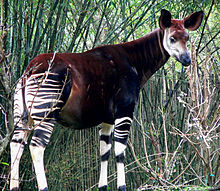The following is a list of megafauna discovered by science since the beginning of the 19th century (with their respective date of discovery). Some of these may have been known to native peoples or reported anecdotally but had not been generally acknowledged as confirmed by the scientific world, until conclusive evidence was obtained for formal studies. In other cases, certain animals were initially considered hoaxes – similar to the initial reception of mounted specimens of the duck-billed platypus (Ornithorhynchus anatinus) in late 18th-century Europe.
In zoology, megafauna (from Greek μέγας megas "large" and Neo-Latin fauna "animal life") are large animals. The most common thresholds to be a megafauna are weighing over 46 kilograms (100 lb) (i.e., having a mass comparable to or larger than a human) or weighing over a tonne, 1,000 kilograms (2,205 lb) (i.e., having a mass comparable to or larger than an ox).
This list includes some of the more notable examples discovered in modern times.
Megafauna believed extinct, but rediscovered

- Burchell's zebra (Equus quagga burchellii), 2004
Megafauna previously unknown from the fossil record
- Western grey kangaroo Notamacropus fuliginosus (1817)
- Malayan tapir Tapirus indicus (1819)
- Red kangaroo Osphranter rufus (1822)
- Lowland anoa Bubalus depressicornis (1827)
- Mountain tapir Tapirus pinchaque (1829)
- Baird's tapir Tapirus bairdii (1865)
- Bonobo Pan paniscus (1928)
- Kouprey Bos sauveli (1937)
- Saola Pseudoryx nghetinhensis (1993)
Megafauna initially believed to have been fictitious or hoaxes
- Przewalski's horse Equus ferus przewalskii (1881 - current wild population descended from zoo breeding since 1945)
- Okapi Okapia johnstoni (1901)
See also
References
- Duckbilled Platypus Museum of Hoaxes.
- ^ Stuart, A. J. (November 1991). "Mammalian extinctions in the Late Pleistocene of northern Eurasia and North America". Biological Reviews. 66 (4): 453–562. doi:10.1111/j.1469-185X.1991.tb01149.x. PMID 1801948. S2CID 41295526.
- Martin, P. S. (1984). "Prehistoric overkill: The global model". In Martin, P. S.; Klein, R. G. (eds.). Quaternary Extinctions: A Prehistoric Revolution. University of Arizona Press. pp. 354–403. ISBN 978-0-8165-1100-6. OCLC 258362030.
- Martin, P. S.; Steadman, D. W. (1999-06-30). "Prehistoric extinctions on islands and continents". In MacPhee, R. D. E (ed.). Extinctions in near time: causes, contexts and consequences. Advances in Vertebrate Paleobiology. Vol. 2. New York: Kluwer/Plenum. pp. 17–56. ISBN 978-0-306-46092-0. OCLC 41368299. Retrieved 2011-08-23. see page 17
- Richard A. Farina; Sergio F. Vizcaino; Gerry De Iuliis (2013). "The Great American Biotic Interchange". Megafauna: Giant Beasts of Pleistocene South America. Indiana University Press, Bloomington, Indiana. p. 150. ISBN 978-0-253-00230-3.
- Bernhard A. Huber; Bradley J. Sinclair; Karl-Heinz Lampe (2005). "Historical Determinants of Mammal Species in Africa". African Biodiversity: Molecules, Organisms, Ecosystems. Springer. p. 294. ISBN 978-0-387-24315-3.
- Groves, C.P. & Bell, H.B. 2004. New investigations on the taxonomy of the zebras genus Equus, subgenus Hippotigris. Mammalian Biology. 69: 182-196.
- "An extraordinary return from the brink of extinction for worlds last wild horse" Archived 2006-07-22 at the Wayback Machine ZSL Living Conservation, December 19, 2005.
| This list is incomplete; you can help by adding missing items. (August 2008) |